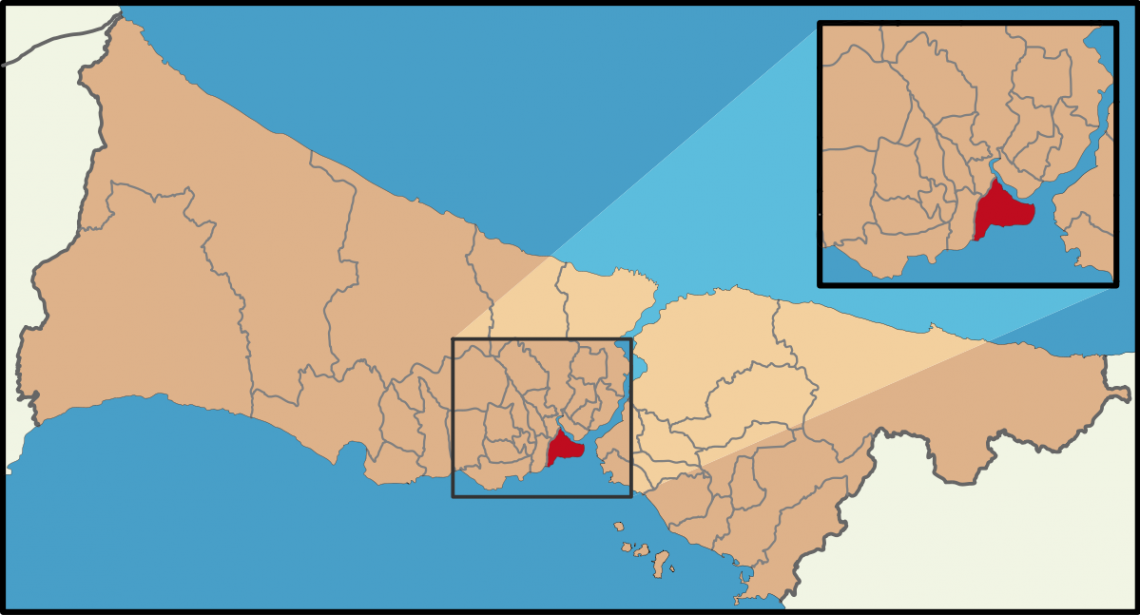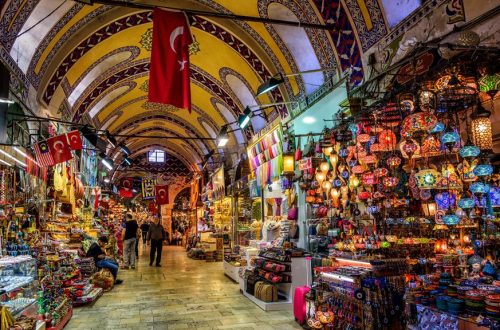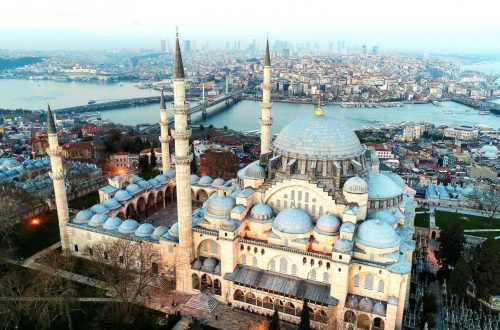
Fatih (Sultanahmet) 15 highlights in the old city of Istanbul
In practical terms, the simplest is the Fatih district, which includes all the areas that were once surrounded by the walls of Constantinople. I know dozens of definitions for the old town of Istanbul.
Since Constantinople itself had something like an old town or a city centre, the second answer would be Sultanahmet.
Sultanahmet is the district at the tip of the peninsula where Constantinople once stood, exactly where the most famous sights in Istanbul are located. Sultanahmet is actually not quite the right answer, as the district is now called Eminönü.
Inner old town: Sultanahmet and Eminonu
Sultanahmet or Eminönü located in Fatih district is the city centre of old Constantinople. The imperial palace and later the palace of the Ottoman sultans stood here. That is why almost all the magnificent buildings are concentrated in the area located at the tip of the peninsula.
1. Hagia Sophia
Built 1,500 years ago under Emperor Justinian, the Cathedral of the Byzantine Empire is one of the landmarks of Istanbul and one of the most famous landmarks in the world. After the conquest of Constantinople, Hagia Sophia was a mosque for almost 600 years.
The Turkish state founder Mustafa Kemal Ataturk had it converted into a museum after the First World War. Today Hagia Sophia is, once again, a mosque. It stands between the Blue Mosque and the Tokpapi Palace. That makes it the centre of the old town of Istanbul.
2. Blue mosque
Hagia Sophia and the Blue Mosque are separated by the square where the hippodrome of Constantinople once stood. You can walk back and forth between the two landmarks in Istanbul’s old town in a maximum of 5 minutes. Here you can find your own contribution to the Blue Mosque “Sultan-Ahemt-Camii”.
3. Topkapi Palace
The Topkapi Palace stands on the tip of the peninsula in Istanbul’s old town, directly behind Hagia Sophia. For 600 years it was the home of the Ottoman sultans, their court and harem. The palace is clearly one of the highlights in Istanbul’s old town, and something that you should definitely not miss! Take a whole afternoon to visit the Sultan’s Palace.
The queue in front of the palace is always very long. Therefore, it is best to plan a visit to the palace in the early morning, when there is not so much going on. You need at least two to three hours for the entire tour. You can also have a bite to eat or a tea in the palace restaurant.
Read More: Guide to Topkapi Palace: Admission, Tickets and Tours!
4. Grand Bazaar
4,000 shops, 30,000 jobs and 500,000 visitors a day – these are the impressive numbers associated with the Grand Bazaar in Istanbul. This area was already assigned to the market districts in old Constantinople, and the bazaar in Istanbul’s old town became large during the days of the Ottoman Empire. To visit, walk 15 minutes from the Blue Mosque to the Bazaar or take the T1 tram from Sultanahmet station for 2 stops.
Read Mer: Guide to the Grand Bazaar in Istanbul: Shopping, Stores and Pictures.
5. Basilica Cistern
The Basilica Cistern is the large “underground palace” in the old town of Istanbul. The name palace is actually incorrect, as it is a cistern that supplied Constantinople with fresh water. It is constructed with dozens of columns, like in the hall of a palace, which has given the Basilica Cistern the nickname “underground palace”. The entrance to the underworld of Istanbul’s old town is directly across from the Hagia Sophia.
6. German fountain and the hippodrome
The square between the Blue Mosque, Hagia Sophia and the Basilica Cistern is where the city’s hippodrome stood in ancient Constantinople. It was where chariot races and all sorts of other events took place. These were the same types of events that were held in the Colosseum of ancient Rome.
On the ground floor of the Museum of Turkish and Islamic Art, you can see an obelisk from Egypt and some other ruins that have been preserved from the hippodrome. The German fountain is a souvenir from the visit of Emperor Wilhelm II to Istanbul in 1900.
7. Museums in the old town
Archaeological Museum: the museum shows a collection of archaeological findings from the entire former Ottoman Empire. These include exhibits from a museum in Egypt, finds from ancient Babylon in Persia and sarcophagi from the Roman cities in Anatolia.
Mosaics Museum: The museum shows the remains of the great Byzantine Imperial Palace. It comprised the entire area between the Blue Mosque and the shore of the Marmara Sea. Today, remnants of these preserved mosaics from the Imperial palace are exhibited in the museum.
Museum of Turkish and Islamic Art: The museum has shown Islamic art since its inception. These include editions of the Koran with splendid calligraphy, handicrafts and objects that are said to have belonged to Mohammed and his companions.
Museum for the History of Science and Technology in Islam: The museum shows technical and scientific achievements from the Islamic world over past centuries.
8. Egyptian Bazaar “Spice Bazaar”
Eat! A sea of scents, colours and delicious food! The Egyptian Bazaar is the perfect place to try Turkish delicacies like baklava, Turkish honey, spices and many other things. It stands directly north of the Galata Bridge, one of the many other interesting places in Istanbul-Eminönü.
Typical souvenirs from the bazaar include baklava, lokum, the Turkish sausage Pastirma, spices, coffee and Turkish tea. You can also eat in the Pandeli Restaurant on the first floor of the Egyptian Bazaar.
The exit towards Eminönü is right across from the Bosporus ferries towards Asia. This is a good daily excursion to take the ferry, along with the Istanbul food. The ferries go to Kadiköy, the most modern area with interesting restaurants, coffee bars and bars in Istanbul.
More: Do you want to become familiarized with the food of Istanbul? My recommendation is The Taste of Two Continents Food Tour in Istanbul.
9. Galata Bridge
The Galata Bridge connects Istanbul’s old town with Galata via the “Golden Horn” bay. The district is actually one of the oldest parts of Istanbul, but was not surrounded by the great city walls of Constantinople.
Galata was a more or less an independent region during the Byzantine Empire, where merchants from Genoa eventually settled. The picture comes from the scenic viewpoint on the Galata Tower. I consider it to be the best viewpoint of the old town with a great view of the Bosporus and the Asian side of Istanbul.
Remaining old town: Fatih
Fatih is the name of the district that was enclosed by the city walls of Constantinople. You will find a lot of other interesting places in it. I’ll start with some of the highlights:
10. Suleymaniye Mosque
The courtyard of the Suleymaniye Mosque.
The Suleymaniye Mosque stands on top of one of the seven hills of ancient Constantinople. The mosque is no longer a part of the innermost section old town of Istanbul today, but consists of an entire district all its own, which is a UNESCO World Heritage Site.
The interior of the mosque, which is red in colour (in comparison to the Blue Mosque), is worth seeing. In my opinion, the view from the terrace of the mosque facing the Golden Horn is one of the most beautiful viewpoints in Istanbul.
11. Chora Church
The Chora “Kariye Camii” Museum is a former Byzantine church with the best-preserved frescoes in Istanbul. It stands on the north-western edge of Istanbul’s old town, near the Theodosian city walls.
Renovation work has been in process, both inside and outside the church for years, so that’s why I’m using a picture from 2008. Inside the Chora church, you can see all the frescoes, perfectly renovated. The exterior of the church is currently encased in scaffolding.
12. Valens Aqueduct
The aqueduct is the oldest, largest structure in the old town. The foundation of the kilometre-long aqueduct dates from the reign of Emperor Constantine I, the founder of Constantinople. At that time, the city was still part of the Roman Empire.
The construction of the aqueduct took several decades until the reign of Emperor Valens. Unfortunately, only 800m of the aqueduct in the old town has been preserved.
13. Pammakaristos Church “Fethiye Camii”
The Pammakaristos Church, like the Chora Church, comes from the Byzantine version of Constantinople. The frescos preserved in the church are less impressive than in the Chora church, but in my opinion the Pammakarostos church or “Fethiye Camii” is still worth a visit. Entry to the church is also included in the Istanbul Museum Pass.
14. Fatih Mosque
The Fatih Camii was commissioned by Sultan Mehmet II, the conqueror of Constantinople. It stands on one of the seven hills on which Istanbul’s old town is built. The sultan’s mausoleum is also located in the building complex. The mosque also gave Istanbul’s old town its Turkish-Ottoman name. Fatih means something like “conqueror” or “winner”.
15. Boundary of the old town: Theodosian city walls
The huge, 19km long city walls protected Constantinople against its enemies for more than 1,000 years. Several times, the Huns and Turks failed to conquer Constantinople until Sultan Mehmet II succeeded in taking the city in 1453. The walls encircle the land and sea borders of Istanbul’s old town, Fatih.




